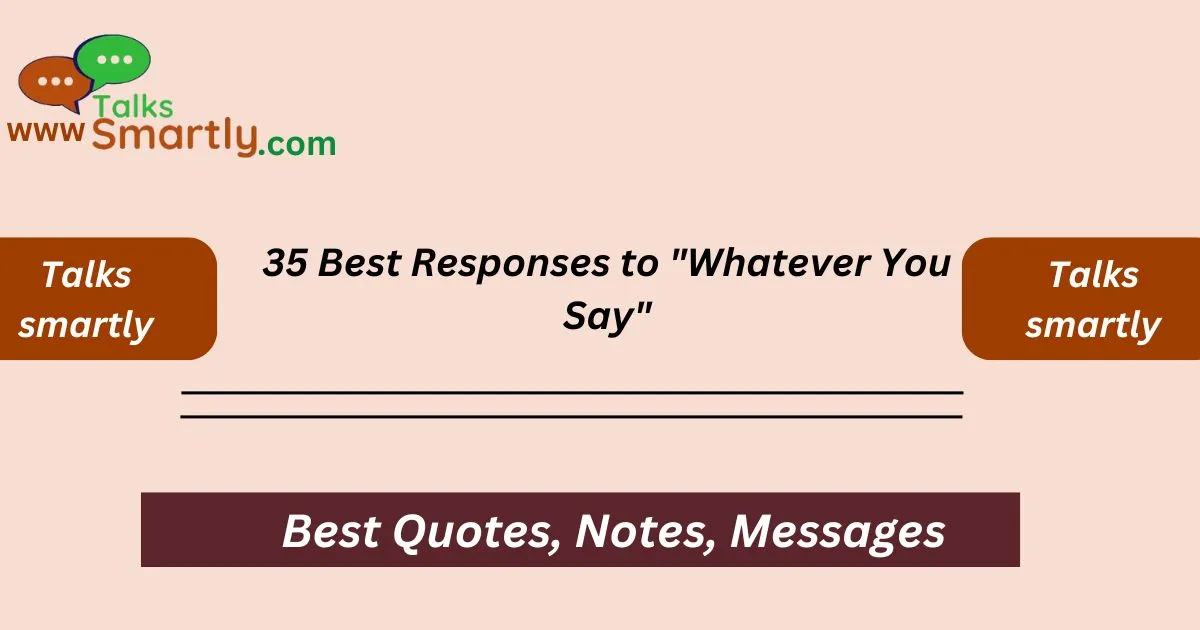“Whatever You Say” can feel dismissive, but the right response can turn the conversation around with respect and clarity.”
We’ve all heard the phrase, “Whatever you say.” It’s one of those responses that can be both passive and dismissive, leaving the speaker feeling dismissed or invalidated. While it might be tempting to react negatively, choosing the right response can change the tone of the conversation.
A well-thought-out reply can maintain respect, open dialogue, or even add humor to the situation. Taking control of the conversation by responding thoughtfully is an important skill in communication. You can either acknowledge the statement and move forward calmly or use it to clarify misunderstandings.
By learning the best ways to respond, you turn awkward moments into opportunities for deeper connection. So, whether you’re dealing with a friend, colleague, or family member, your response will set the tone for the discussion that follows.
In this blog post, we’ll explore 35 effective responses to “Whatever you say” that can help you in different situations. These responses will guide you on how to manage tricky situations with grace, humor, or assertiveness—whichever the occasion demands. The right words can turn an awkward or dismissive comment into a meaningful conversation.
35 Best Responses to “Whatever You Say”
- “I appreciate your input.”
- “Let’s make sure we’re on the same page.”
- “That sounds good to me.”
- “If you’re sure, then I’m happy to go with that.”
- “I think we should talk more about this.”
- “I didn’t mean to sound overbearing.”
- “Your thoughts matter to me.”
- “I hear you, let’s proceed.”
- “I don’t want to assume anything.”
- “Let’s work together on this.”
- “What’s really on your mind?”
- “I want to make sure we’re both okay with this.”
- “I respect your stance.”
- “I think we’re missing something.”
- “Are you okay with this decision?”
- “Let’s make sure we’re both comfortable.”
- “Is there something else we need to discuss?”
- “I hope we’re clear on this.”
- “I trust your judgment.”
- “We can revisit this if needed.”
- “Let’s find a solution together.”
- “I value your perspective.”
- “I’m open to suggestions.”
- “I don’t want to make assumptions.”
- “Let’s make a decision we’re both happy with.”
- “It’s important that we both agree.”
- “I want to make sure you’re okay with this.”
- “I don’t want this to be one-sided.”
- “Can we explore this further?”
- “Let’s make sure this works for both of us.”
- “I don’t want you to feel left out.”
- “Let’s take a moment to think this over.”
- “I hope we’re both on the same page.”
- “I don’t want this to be misunderstood.”
- “I’m here if you want to discuss it further.”
1. “I appreciate your input.”
This response shows respect even if the other person seems dismissive. It puts you in control of the conversation, and by acknowledging them, you show maturity.
Example: If someone says, “Whatever you say,” in a meeting, you can reply, “I appreciate your input, and I’ll consider it moving forward.”
2. “Let’s make sure we’re on the same page.”
Use this to refocus the conversation and ensure there’s mutual understanding. It prevents the dismissal from derailing communication.
Example: In a disagreement, you might say, “Let’s make sure we’re on the same page about this project.”
3. “That sounds good to me.”
This is an agreeable response that allows the conversation to move forward without confrontation.
Example: When someone uses “Whatever you say,” during planning, respond with, “That sounds good to me, let’s move ahead.”
4. “If you’re sure, then I’m happy to go with that.”

This response shifts responsibility back to them, making sure they own their decision.
Example: When someone says, “Whatever you say,” about a work process, you could reply, “If you’re sure, I’m happy to go with that.”
5. “I think we should talk more about this.”
If the situation calls for further discussion, use this response to keep the dialogue open.
Example: If a partner says, “Whatever you say,” about a big decision, you might reply, “I think we should talk more about this to ensure we both agree.”
6. “I didn’t mean to sound overbearing.”
This is a humble response that shows you’re willing to take feedback while inviting clarity.
Example: If someone responds, “Whatever you say,” after you give instructions, reply with, “I didn’t mean to sound overbearing; let’s work together on this.”
7. “Your thoughts matter to me.”
This phrase affirms the other person’s importance in the conversation and encourages engagement.
Example: If a friend says, “Whatever you say,” you can respond, “Your thoughts matter to me, so I want to make sure we’re aligned.”
8. “I hear you, let’s proceed.”
Acknowledging the comment and moving forward helps diffuse tension while keeping things professional.
Example: In a work environment, reply to “Whatever you say,” with, “I hear you, let’s proceed as discussed.”
9. “I don’t want to assume anything.”
This response clarifies that you value clear communication and don’t want to jump to conclusions.
Example: If a colleague says, “Whatever you say,” during a project, reply with, “I don’t want to assume anything, so let’s ensure we’re aligned.”
10. “Let’s work together on this.”
This approach emphasizes collaboration rather than letting one person dominate the conversation.
Example: During a team discussion, you might say, “Let’s work together on this and make sure we both feel comfortable.”
11. “What’s really on your mind?”
It opens the door to deeper discussion and shows you care about their true thoughts.
Example: When someone dismissively says, “Whatever you say,” you can ask, “What’s really on your mind? I value your opinion.”
12. “I want to make sure we’re both okay with this.”
This response shows you’re interested in ensuring both parties are comfortable moving forward.
Example: In a relationship, you might say, “I want to make sure we’re both okay with this before we proceed.”
13. “I respect your stance.”
Respectful but firm, this phrase acknowledges the other person without agreeing outright.
Example: When someone responds with, “Whatever you say,” you can calmly reply, “I respect your stance, let’s see how it works out.”
14. “I think we’re missing something.”
This response signals that there might be an underlying issue that needs addressing.
Example: In a work scenario, respond to “Whatever you say,” with, “I think we’re missing something important here, let’s revisit the details.”
15. “Are you okay with this decision?”
It checks in with the other person to ensure they’re comfortable and haven’t disengaged.
Example: If a friend says, “Whatever you say,” you can ask, “Are you really okay with this decision?”
16. “Let’s make sure we’re both comfortable.”
This response ensures that the decision being made is agreed upon by both parties and promotes collaboration.
Example: If someone says, “Whatever you say,” about a shared project, you can reply with, “Let’s make sure we’re both comfortable with the direction.”
17. “Is there something else we need to discuss?”
This approach encourages the person to open up if there’s a hidden concern or issue.
Example: If a friend says, “Whatever you say,” dismissively, you could ask, “Is there something else we need to discuss?”
18. “I hope we’re clear on this.”
This response reinforces the importance of clarity and understanding before moving forward.
Example: In a work discussion, when someone says, “Whatever you say,” reply with, “I hope we’re clear on this so there’s no confusion later.”
19. “I trust your judgment.”
By expressing trust, you shift the responsibility to the other person and show confidence in their decision.
Example: In response to “Whatever you say,” you could say, “I trust your judgment, so let’s go with your choice.”
20. “We can revisit this if needed.”
Offering the possibility of revisiting the topic later shows flexibility and keeps the conversation open.
Example: If someone says, “Whatever you say,” about a decision, reply with, “We can revisit this if needed after we’ve seen the results.”
21. “Let’s find a solution together.”
This approach emphasizes teamwork and problem-solving rather than allowing one person to take control.
Example: If a colleague says, “Whatever you say,” during a discussion, respond with, “Let’s find a solution together that works for both of us.”
22. “I value your perspective.”
This phrase shows respect and interest in the other person’s viewpoint, encouraging them to share more.
Example: When someone says, “Whatever you say,” respond with, “I value your perspective, so let’s discuss this further.”
Best Responses to “Time Will Tell”
23. “I’m open to suggestions.”
This is an invitation for collaboration and additional input, which can help reduce tension.
Example: If a teammate says, “Whatever you say,” you can reply, “I’m open to suggestions if you have any other ideas.”
24. “I don’t want to make assumptions.”
This response shows that you want clarity and are not assuming the other person’s feelings or thoughts.
Example: In response to “Whatever you say,” you could say, “I don’t want to make assumptions, so let’s ensure we both agree.”
25. “Let’s make a decision we’re both happy with.”
It’s important to ensure that both parties are satisfied with the decision.
Example: In a personal situation, if someone says, “Whatever you say,” respond with, “Let’s make a decision we’re both happy with, so there are no regrets.”
26. “It’s important that we both agree.”
This emphasizes mutual agreement and avoids one person feeling left out of the decision-making process.
Example: If a friend says, “Whatever you say,” you can reply with, “It’s important that we both agree, let’s discuss it further.”
27. “I want to make sure you’re okay with this.”
This is a caring and considerate response that ensures the other person is truly comfortable with the decision.
Example: If a partner says, “Whatever you say,” you could respond with, “I want to make sure you’re okay with this before we move ahead.”
28. “I don’t want this to be one-sided.”
This response encourages balanced participation in the conversation or decision-making process.
Example: In a group setting, if someone says, “Whatever you say,” you can reply with, “I don’t want this to be one-sided, let’s all contribute.”
29. “Can we explore this further?”

This opens the door for more discussion and invites the other person to share their thoughts.
Example: In response to “Whatever you say,” during a brainstorming session, you could say, “Can we explore this further before making a final decision?”
30. “Let’s make sure this works for both of us.”
This response ensures that both parties benefit from the decision, maintaining balance and fairness.
Example: If someone says, “Whatever you say,” about plans, you could reply, “Let’s make sure this works for both of us.”
31. “I don’t want you to feel left out.”
This caring response ensures that the other person feels included in the decision.
Example: If a friend says, “Whatever you say,” you can respond with, “I don’t want you to feel left out, so let’s talk it through.”
32. “Let’s take a moment to think this over.”
This allows time for reflection, which can prevent rushed decisions.
Example: In response to “Whatever you say,” you could say, “Let’s take a moment to think this over before deciding.”
33. “I hope we’re both on the same page.”
This response ensures mutual understanding and alignment.
Example: If someone says, “Whatever you say,” about an upcoming event, you could reply with, “I hope we’re both on the same page before we finalize anything.”
34. “I don’t want this to be misunderstood.”
This response helps prevent potential misunderstandings and miscommunications.
Example: In a work discussion, if someone says, “Whatever you say,” you might respond, “I don’t want this to be misunderstood, so let’s clarify it.”
35. “I’m here if you want to discuss it further.”
This is an open and inviting response that leaves the door open for further conversation.
Example: If a colleague says, “Whatever you say,” you can reply with, “I’m here if you want to discuss it further later.”
ANSWER TO KEY QUESTION
1. What if “Whatever you say” feels dismissive?
It’s important to assess the tone. Sometimes it’s not meant negatively, but if it feels dismissive, respond with something that invites further conversation or clarity.
2. How can I avoid sounding confrontational?
Use calm, open-ended responses like “Let’s make sure we’re aligned” to invite collaboration without escalating the situation.
3. What’s the best way to handle this in professional settings?
Stay professional and positive. Acknowledge the comment and steer the conversation back to the main objective with a respectful tone.
4. What if the person says it sarcastically?
A light or neutral response like, “I appreciate your input” can diffuse sarcasm while keeping the conversation focused.
5. Can humor be an effective response?
Yes, if the situation allows it. For example, responding with something light-hearted like, “Glad we’re in agreement!” can ease tension.
Conclusion
The phrase “Whatever you say” can be tricky to navigate, but with the right responses, you can keep communication flowing smoothly. Whether you’re dealing with a passive comment, sarcasm, or genuine agreement, your reply can either invite more dialogue or close off the conversation.
By using these 35 responses, you’ll be equipped to handle this phrase in various situations—professionally, personally, or socially. Stay calm, respectful, and clear in your communication, and you’ll maintain control of the conversation with confidence.












